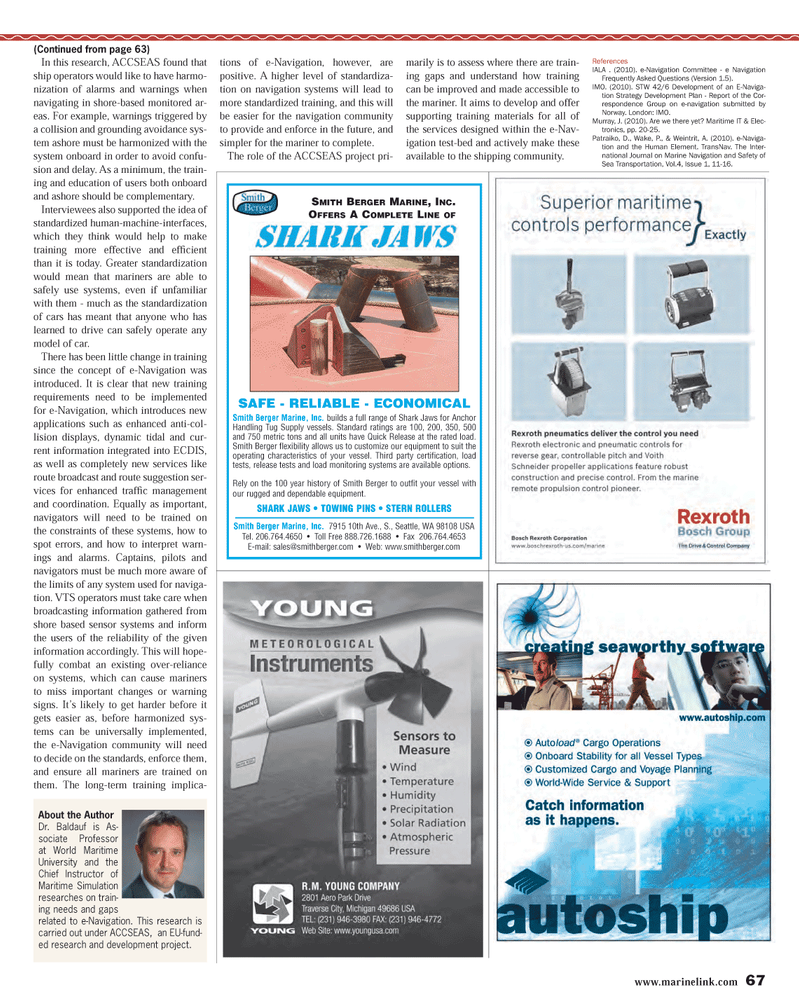
Page 67: of Maritime Reporter Magazine (November 2013)
Marine Propulsion Annual
Read this page in Pdf, Flash or Html5 edition of November 2013 Maritime Reporter Magazine
www.marinelink.com 67In this research, ACCSEAS found that ship operators would like to have harmo-nization of alarms and warnings when navigating in shore-based monitored ar- eas. For example, warnings triggered by a collision and grounding avoidance sys-tem ashore must be harmonized with the system onboard in order to avoid confu-sion and delay. As a minimum, the train- ing and education of users both onboard and ashore should be complementary. Interviewees also supported the idea of standardized human-machine-interfaces, which they think would help to make training more effective and ef Þ cient than it is today. Greater standardization would mean that mariners are able to safely use systems, even if unfamiliar with them - much as the standardization of cars has meant that anyone who has learned to drive can safely operate any model of car. There has been little change in training since the concept of e-Navigation was introduced. It is clear that new training requirements need to be implemented for e-Navigation, which introduces new applications such as enhanced anti-col-lision displays, dynamic tidal and cur- rent information integrated into ECDIS, as well as completely new services like route broadcast and route suggestion ser- vices for enhanced trafÞ c management and coordination. Equally as important, navigators will need to be trained on the constraints of these systems, how to spot errors, and how to interpret warn-ings and alarms. Captains, pilots and navigators must be much more aware of the limits of any system used for naviga-tion. VTS operators must take care when broadcasting information gathered from shore based sensor systems and inform the users of the reliability of the given information accordingly. This will hope- fully combat an existing over-reliance on systems, which can cause mariners to miss important changes or warning signs. It?s likely to get harder before it gets easier as, before harmonized sys-tems can be universally implemented, the e-Navigation community will need to decide on the standards, enforce them, and ensure all mariners are trained on them. The long-term training implica- tions of e-Navigation, however, are positive. A higher level of standardiza- tion on navigation systems will lead to more standardized training, and this will be easier for the navigation community to provide and enforce in the future, and simpler for the mariner to complete. The role of the ACCSEAS project pri- marily is to assess where there are train-ing gaps and understand how training can be improved and made accessible to the mariner. It aims to develop and offer supporting training materials for all of the services designed within the e-Nav-igation test-bed and actively make these available to the shipping community. Smith Berger Marine, Inc.builds a full range of Shark Jaws for AnchorHandling Tug Supply vessels. Standard ratings are 100, 200, 350, 500 and 750 metric tons and all units have Quick Release at the rated load.Smith Berger flexibility allows us to customize our equipment to suit theoperating characteristics of your vessel. Third party certification, loadtests, release tests and load monitoring systems are available options. Rely on the 100 year history of Smith Berger to outfit your vessel with our rugged and dependable equipment.SMITHBERGERMARINE, INC.OFFERSA COMPLETELINEOF SHARK JAWS ? TOWING PINS ? STERN ROLLERS Smith Berger Marine, Inc.7915 10th Ave., S., Seattle, WA 98108 USA Tel. 206.764.4650 ? Toll Free 888.726.1688 ? Fax 206.764.4653 E-mail: [email protected] ? Web: www.smithberger.com SAFE - RELIABLE - ECONOMICAL(Continued from page 63) References IALA . (2010). e-Navigation Committee - e Navigation Frequently Asked Questions (Version 1.5). IMO. (2010). STW 42/6 Development of an E-Naviga- tion Strategy Development Plan - Report of the Cor- respondence Group on e-navigation submitted by Norway. London: IMO. Murray, J. (2010). Are we there yet? Maritime IT & Elec- tronics, pp. 20-25. Patraiko, D., Wake, P., & Weintrit, A. (2010). e-Naviga- tion and the Human Element. TransNav. The Inter- national Journal on Marine Navigation and Safety of Sea Transportation, Vol.4, Issue 1, 11-16. About the AuthorDr. Baldauf is As- sociate Professor at World Maritime University and the Chief Instructor of Maritime Simulation researches on train- ing needs and gaps related to e-Navigation. This research is carried out under ACCSEAS, an EU-fund-ed research and development project. MR #11 (66-73).indd 67MR #11 (66-73).indd 6711/13/2013 11:30:13 AM11/13/2013 11:30:13 AM

 66
66

 68
68
